Key Takeaways
- AMC bridges the gap between surface-level reporting and actionable insights. Instead of just knowing what happened, you can uncover why it happened and how to act on it.
- Targeting use cases ensure your ad spend goes to the audiences that matter most. From cart abandoners to high-value lookalikes, AMC helps you create precise audiences that improve efficiency and reduce wasted spend.
- Reporting use cases give clarity inside the funnel. Tools like path-to-purchase, campaign overlap, and new-to-brand vs. repeat buyer analysis show how campaigns work together and where to optimize.
- Attribution use cases prove ROI with accuracy. Custom models like linear, time-decay, or position-based ensure every touchpoint gets fair credit, giving you confidence in budget allocation.
- Analytics and audience creation use cases work best together. Insights feed into targeting strategies, which are then validated through attribution—creating a closed-loop growth system.
- Advanced applications unlock long-term growth With cross-channel attribution, predictive modeling, creative optimization, and incrementality testing, AMC evolves into a strategic engine, not just a reporting tool.
- Start small, scale smart. The fastest path to results is to pair one reporting use case with one targeting use case, then measure the outcome with a simple attribution model. From there, expand into more advanced strategies.
If you’ve been running ads on Amazon long enough, you already know the limitations of the Ads Console. Standard reports tell you what happened, but not why it happened or what to do next. That’s where Amazon Marketing Cloud (AMC) steps in.
AMC gives you event-level data in a privacy-safe environment, allowing you to answer questions that traditional reporting simply can’t. The best part? You don’t need to start from scratch. Amazon provides a Use Case Library with pre-built SQL queries and business context so you can begin running advanced analyses immediately.
In this guide, we’ll explore 20+ Amazon Marketing Cloud use cases and show how they bring new possibilities in targeting, reporting, and attribution. Whether you’re chasing better audience segmentation, more accurate campaign measurement, or custom attribution modeling, these use cases are ready to implement today.
Why AMC Use Cases Matter
Most sellers eventually hit the same ceiling with the Amazon Ads Console. You see impressions, clicks, and sales, but those top-line numbers don’t tell the full story. They won’t show you how different ad types work together, which audiences are truly driving profitability, or what happens before and after the purchase.
That’s where Amazon Marketing Cloud (AMC) changes the equation. Think of it as your own data laboratory or a secure space where you can ask deeper questions, dig into the full shopping journey, and build solutions designed for your brand’s growth challenges.
With AMC use cases, you can:
- Map the customer journey with clarity: Understand every step buyers take: from first impression, to detail page view, to add-to-cart, and finally conversion. This visibility shows you which campaigns build awareness and which ones close the sale.
- Create precision-targeted audiences: Retarget shoppers who watched your Sponsored Brand video but didn’t buy. Build lookalikes of your highest-value repeat customers. Then, activate these segments directly in DSP or Sponsored Display to turn insights into measurable results.
- Apply attribution that reflects reality: Move beyond last-click models that over-credit the final ad. With AMC, you can use linear, time-decay, or position-based attribution to see the true impact of every channel and invest with confidence.
The best part? You don’t need to do the things from scratch. Amazon has built an AMC Use Case Library: a collection of ready-to-run SQL templates that provide:
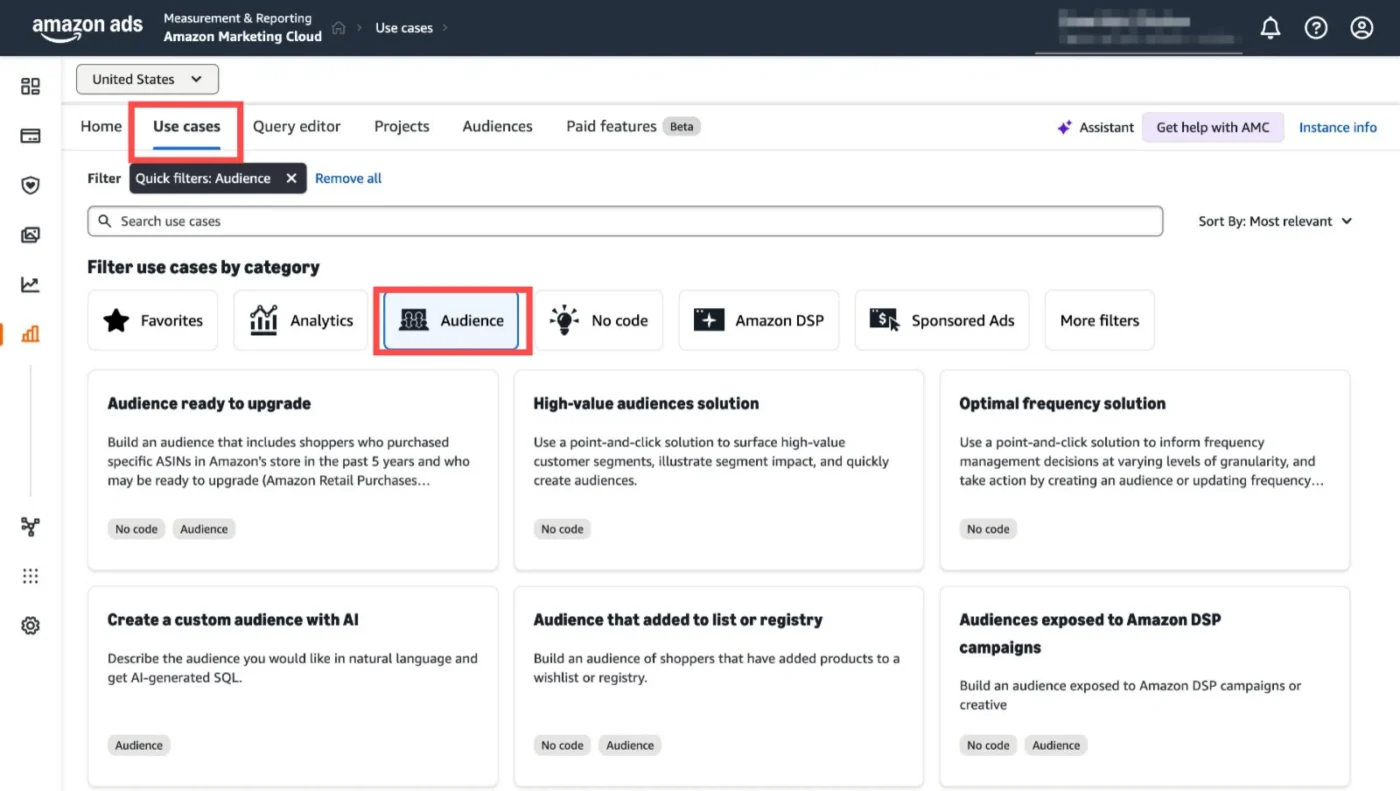
- Business context: Why the query matters and what it solves.
- Step-by-step instructions: How to adapt and run it for your account.
- Interpretation guidance: How to act on the results and optimize campaigns.
AMC use cases matter because they replace surface-level reporting with data truth. They empower you to optimize spend, sharpen targeting, and grow with confidence.
- Analytics Use Cases
You’ve probably stared at the Amazon Ads Console wondering: “Why don’t these numbers explain where my sales are really coming from?” Impressions, clicks, and ROAS tell part of the story, but not enough to answer the bigger questions:
- Which campaigns are actually driving new-to-brand customers?
- How do different ad types work together in the path to purchase?
- Are you overspending by hitting the same audience twice?
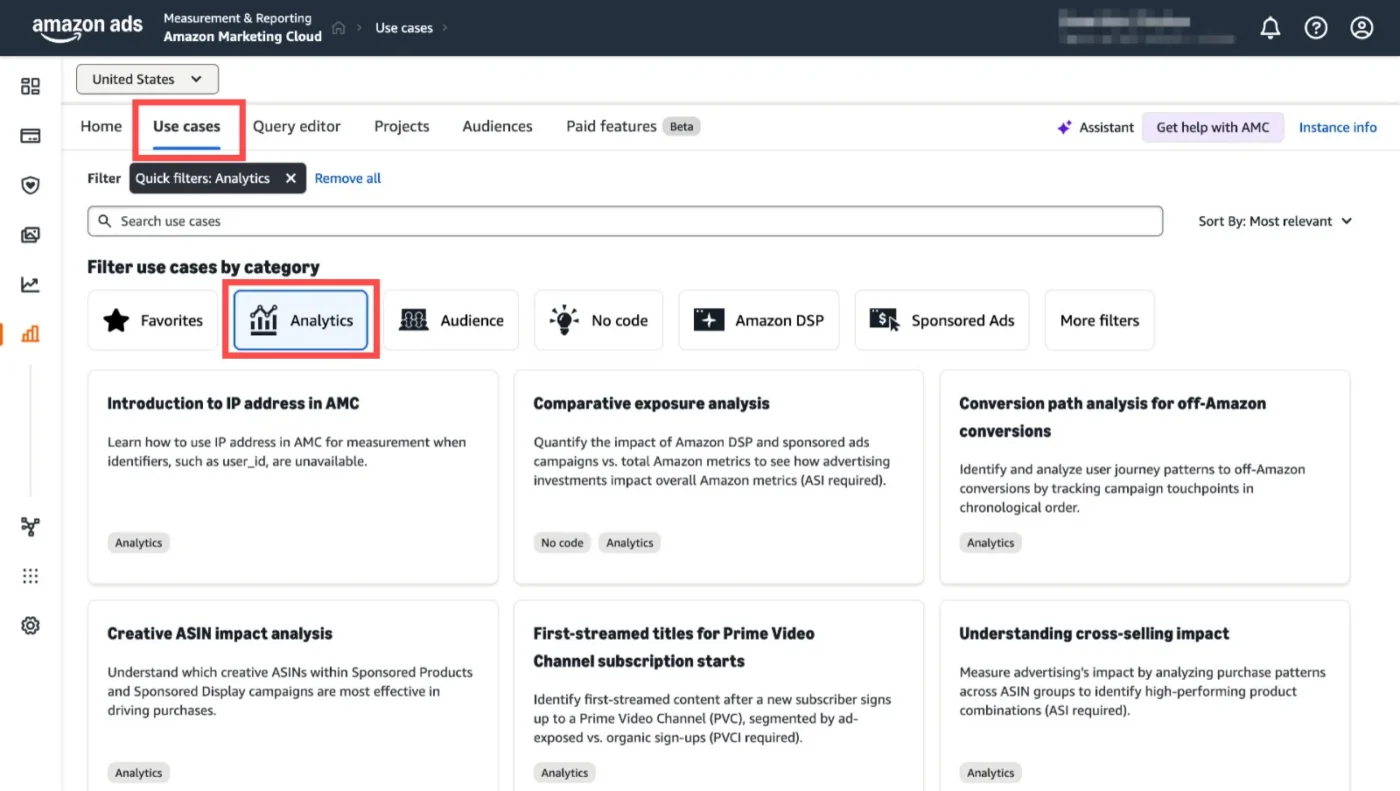
That’s where Amazon Marketing Cloud (AMC) comes in. It transforms raw signals into insights that sellers and brands can act on. Instead of being trapped in siloed dashboards, you can finally connect the touchpoints.
Visual Framework: From Data to Decisions
AMC Data → Query / Use Case → Actionable Insight → Campaign Optimization
1. Performance Deep Dive
Clicks and sales numbers only scratch the surface. With AMC, you can break results down by creative, placement, or shopper segment to see what’s really moving the needle.
Example: Instead of stopping at “this Sponsored Products campaign generated $20K,” you’ll see which ad groups drove new-to-brand customers, which ones brought repeat buyers, and how results shifted during promotions. That clarity helps you focus on the budget where it has the greatest impact.
2. Audience Insights
Understanding who clicks is helpful. Understanding who converts is game-changing. AMC ties audience attributes, like age, household income, or category affinity to actual engagement and conversion data.
Step 1: find out high-value audience with the help of data
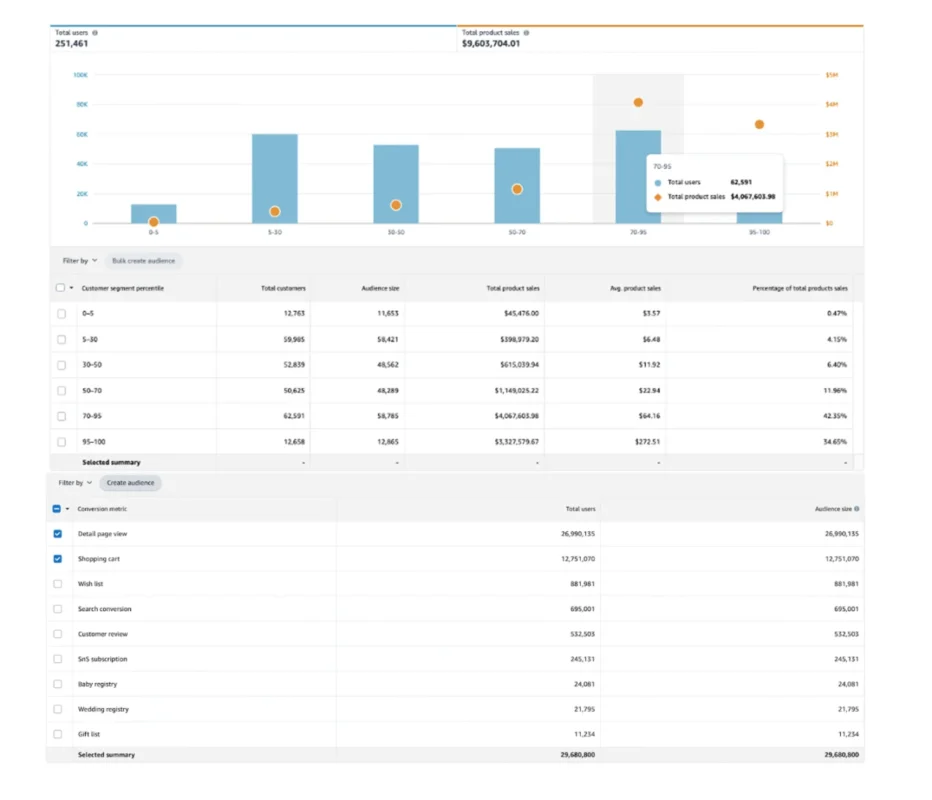
Step 2: Create Audience based on AMC Recommendations
Step 3: Create Custom Audience Based on User Journey
Example: You might find that younger audiences respond strongly to Sponsored Brand video ads, while older audiences are more likely to purchase after seeing Sponsored Display. That insight helps you adjust your media mix for higher efficiency.
3. Shopping Journey Analysis
Every purchase follows a path. AMC lets you map the most common steps customers take before buying, so you can identify where they engage and where they drop off.
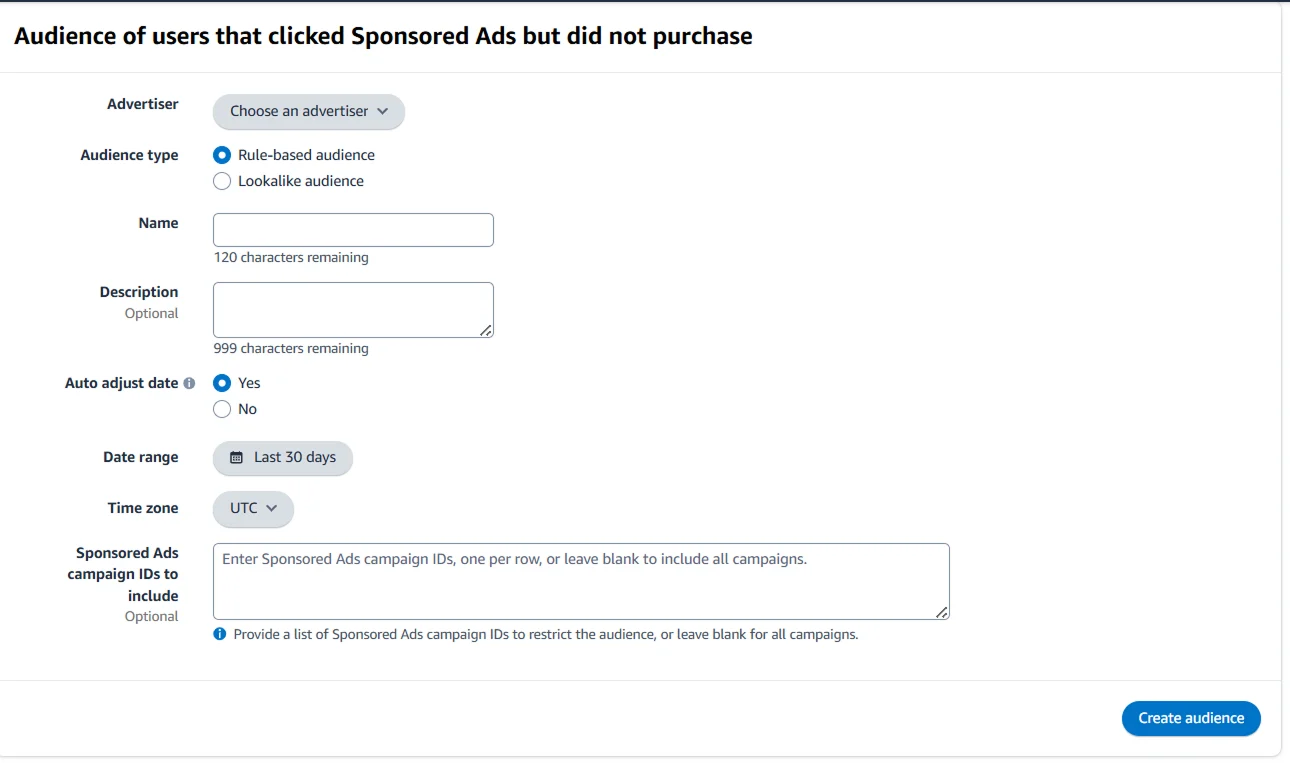
Example: If AMC shows shoppers often click a Sponsored Brand ad, view your detail page, but abandon before adding to cart, that signals a need to strengthen your product page content, reviews, or offer.
4. Media Mix Analysis
Marketers often wonder how different ad types work together. AMC provides the answer by showing the combined impact of Sponsored Ads, DSP, and Streaming TV.

Example: Streaming TV may not appear to drive direct conversions, but AMC might reveal it boosts engagement rates in Sponsored Products that follow, proving its role in building upper-funnel awareness.
5. Omnichannel Impact Assessment
AMC doesn’t stop at Amazon sales. It can show how ads influence purchases across retail partners or your DTC store, giving you a more complete view of ROI.
Example: A DSP campaign may not show much lift in Amazon orders, but AMC could reveal it drives a 5% increase in retail store sales for one of your partners.
6. Custom Attribution Models
Last-click attribution oversimplifies the customer journey. AMC gives you the flexibility to apply linear, time-decay, or position-based models so credit is shared more accurately.
Example: Instead of giving 100% credit to the last Sponsored Product click, you might assign 40% to the first impression, 20% to a DSP mid-funnel ad, and 40% to the final click. That shows each channel’s real contribution.
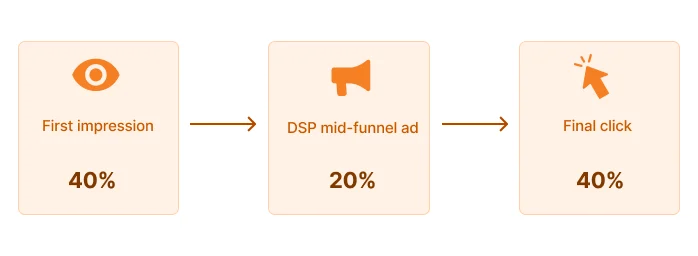
7. Path-to-Conversion
Want to know the exact sequence of ads that led to a sale? AMC breaks it down step by step, giving you visibility into how campaigns build on one another.

Example: You might discover that 70% of conversions begin with Sponsored Brand ads, are reinforced by DSP retargeting, and close with Sponsored Products. With that knowledge, you can design campaigns to mirror the journey.
8. Overlap Analyses
When multiple campaigns hit the same audience, you risk wasted impressions. AMC overlap reports show you where this is happening so you can refine targeting.
Example: If 40% of your DSP audience is also receiving Sponsored Display ads, AMC highlights the redundancy so you can tighten targeting and free up budget for incremental reach.
9. Campaign Measurement
Campaigns rarely work in isolation, but standard reporting treats them that way. AMC lets you see performance in context, showing how campaigns support each other across the funnel.
Example: A Sponsored Brands campaign might look like it has low ROAS in the console, but AMC reveals it plays a key role in awareness that later drives Sponsored Products conversions.
10. Reach & Frequency Optimization
Ad exposure is a balancing act where too much leads to fatigue, too little means missed sales. AMC helps you find the sweet spot.
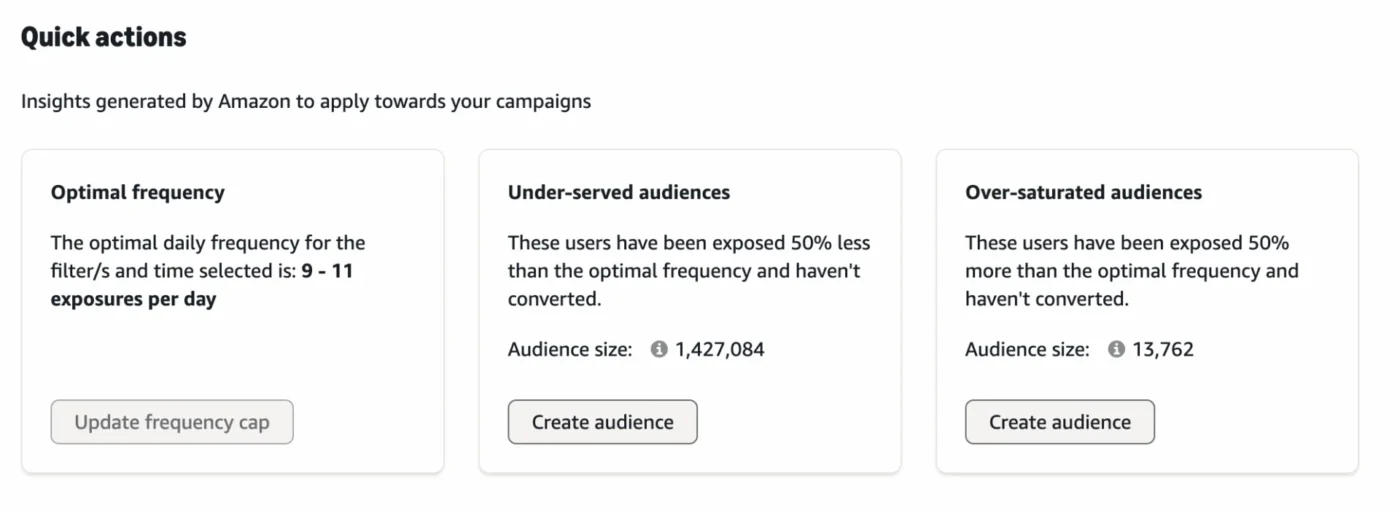
Example: If data shows conversion rates plateau after five impressions, you can cap frequency there and redirect spend to new audiences, maximizing both reach and efficiency.
11. Technical Queries
Sometimes the biggest wins come from cleaning and reshaping your data. AMC’s technical queries make it easier to merge datasets, format IDs, or group SKUs under parent ASINs for cleaner analysis.
Example: You can consolidate multiple SKUs under a parent ASIN to see campaign performance at the brand or product line level, ensuring your reporting reflects the real structure of your catalog.
12. Audience Refinement
Not every audience segment deserves the same spend. AMC lets you refine segments to maximize profitability and minimize wasted impressions.

Example: Instead of remarketing to all cart abandoners, you can focus on those who abandoned high-margin products, ensuring your retargeting dollars go where they’ll generate stronger returns.
13. Supply Optimization
Advertising and inventory must work hand in hand. AMC shows you which products perform best under which channels so you can align budget with supply.
Example: If AMC reveals one SKU consistently converts through DSP but not Sponsored Products, you can shift spend toward DSP and avoid wasting budget on placements that underperform for that item.
Why It Matters
These analytics use cases move you beyond surface reporting and into the realm of actionable intelligence. They help you spend smarter, cut waste, and build confidence in your advertising strategy. Instead of guessing which campaigns drive results, you’ll have data-backed clarity on how ads actually influence conversions, awareness, and growth.
Audience Creation Use Cases: Smarter Targeting
You’ve probably asked yourself: “How do I stop wasting ad spend on broad audiences and focus only on the shoppers who actually drive growth?”
That’s exactly where Amazon Marketing Cloud (AMC) makes the difference. Instead of relying on generic targeting, you can create data-driven, high-precision audiences built from real engagement and conversion signals. And because AMC connects directly with DSP and Sponsored Ads, these insights turn into immediate, measurable actions.
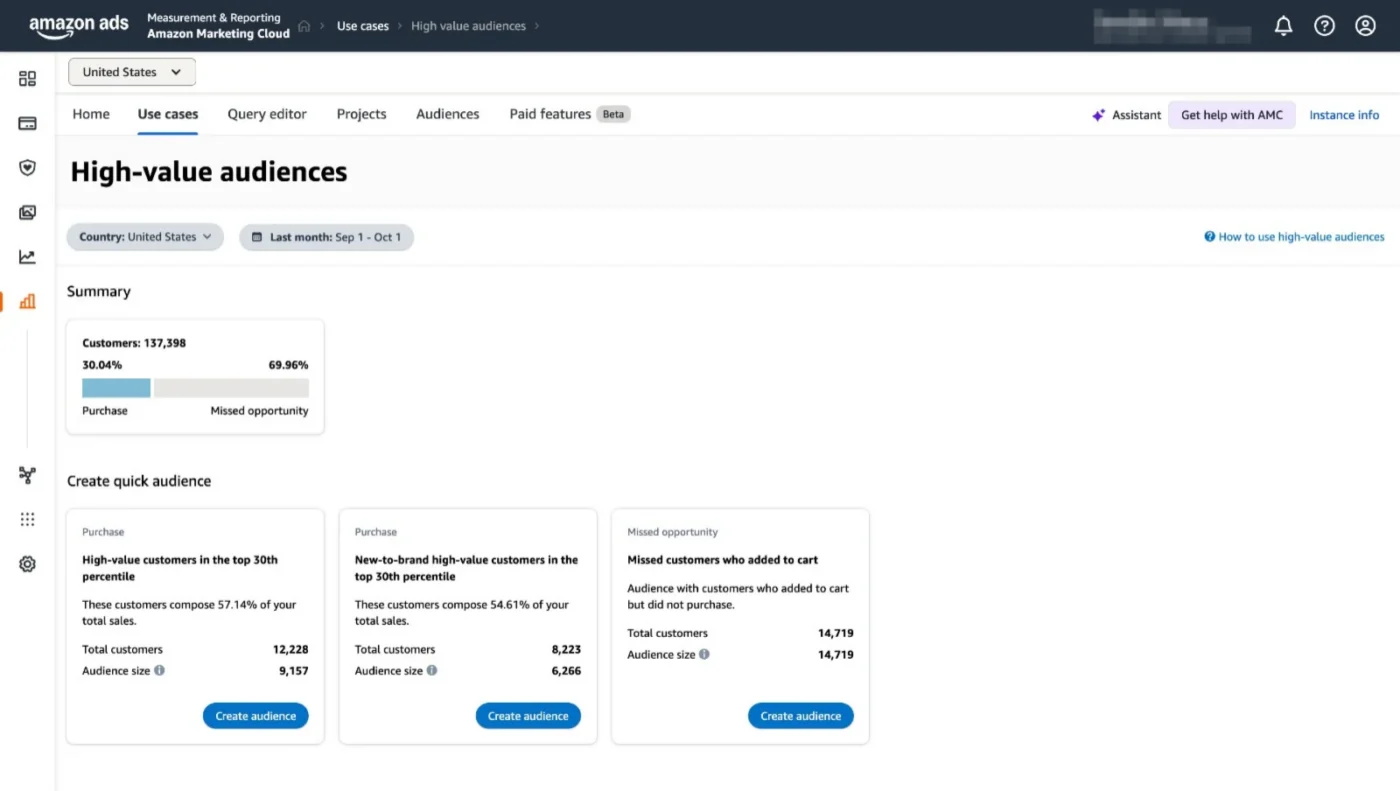
Here are some of the most impactful audience creation use cases that can transform how you target on Amazon:
1. Ad Engagement Audiences
Shoppers who interact with your ads often show intent, even if they do not purchase immediately. AMC allows you to capture this audience and reach them again through the right channels.
Example: A Sponsored Brands Video campaign drives high engagement but low conversions. With AMC, you can build an audience of those viewers and re-engage them through Sponsored Products or DSP, keeping your brand present as they continue their decision process.
2. Cart Abandoners
Cart abandonment represents lost potential revenue, and AMC helps you address it directly. By building retargeting audiences around cart abandoners, you can reconnect with high-intent shoppers who paused before completing checkout.
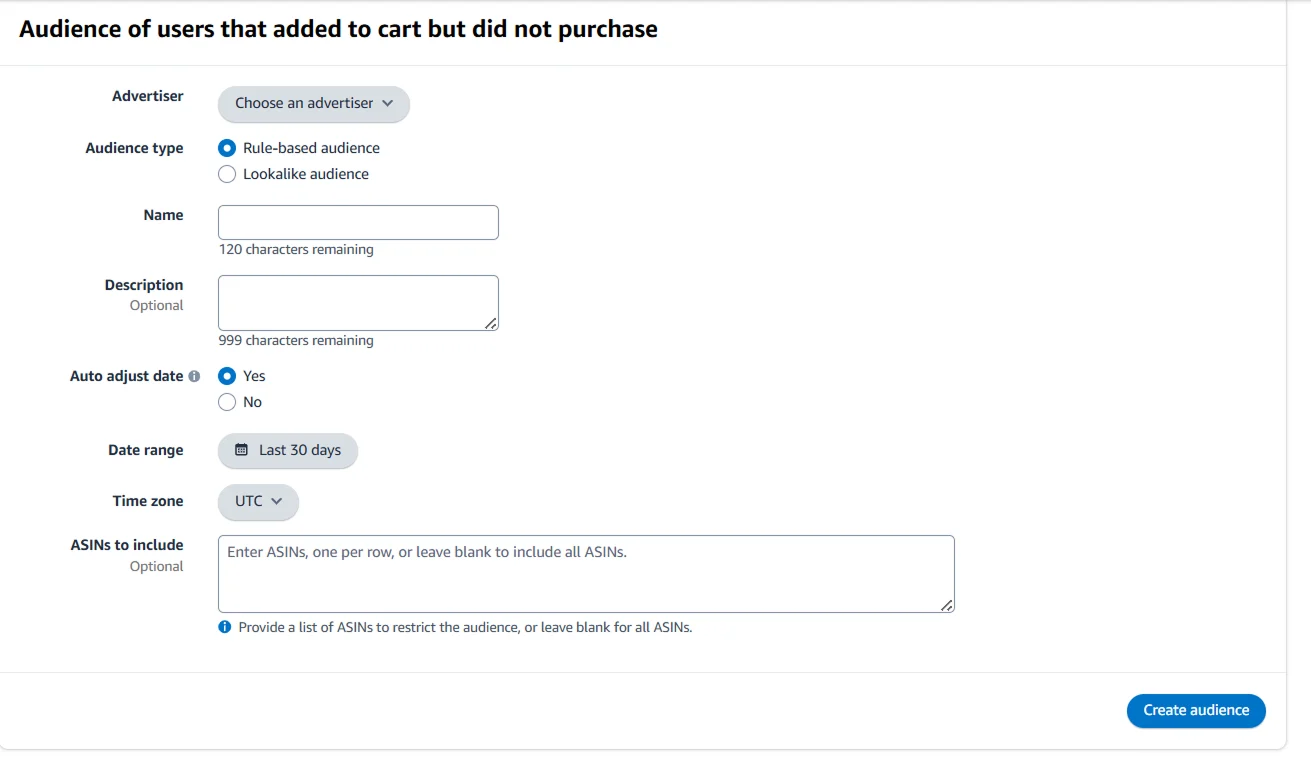
Example: A customer adds a $50 skincare product to their cart but does not finalize the purchase. AMC allows you to serve a Sponsored Display reminder or DSP campaign, giving them another opportunity to complete the order.
3. High-Value Lookalikes
Your most loyal customers often share common behaviors. AMC enables you to scale by creating lookalike audiences based on these high-value segments, helping you attract shoppers who are more likely to become repeat buyers.

Example: If your top 10 percent of customers purchase across multiple categories, AMC can identify similar shoppers. Targeting these lookalikes helps you grow efficiently while building loyalty-focused acquisition strategies.
4. Custom Audiences from DSP and Sponsored Ads
Shoppers engage with multiple ad types before deciding, and AMC lets you combine these interactions into custom audiences that reflect the full journey.
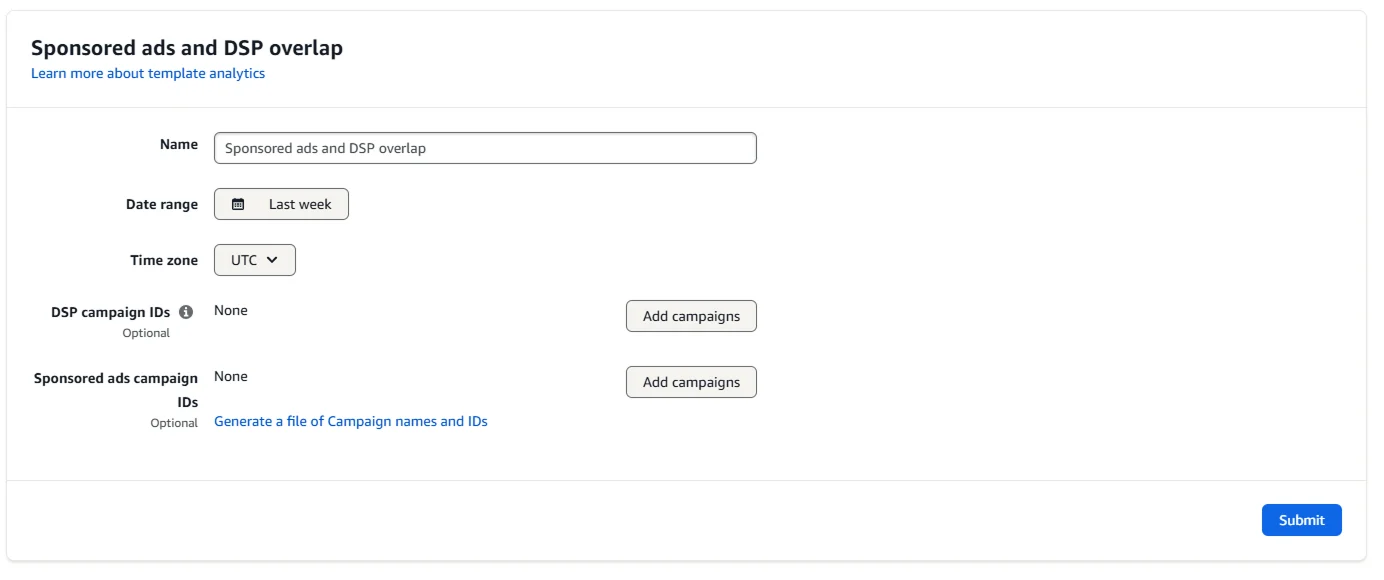
Example: A shopper clicks a Sponsored Brand ad, views a product page, but does not purchase. AMC records this sequence, and you can create a DSP retargeting audience that delivers relevant ads at the next stage of their journey.
5. Conversion-Event Audiences
Not all conversions have equal weight, and AMC makes it possible to define audiences based on meaningful events such as product views, add-to-cart, or repeat purchases.
Example: A supplement brand targets shoppers who viewed its protein powder detail page but did not buy, while also building a segment of buyers who purchased once but have not reordered within 60 days.
6. First-Party Data Integration
AMC allows you to integrate first-party data, giving you a unified view of your customers across Amazon and external channels. CRM lists, loyalty programs, or email subscribers can be uploaded and enriched with Amazon signals for stronger targeting.
Example: Upload your newsletter subscribers into AMC, then measure how many saw your Amazon ads and later converted. This creates alignment between off-Amazon and on-Amazon strategies, ensuring every touchpoint contributes to growth.
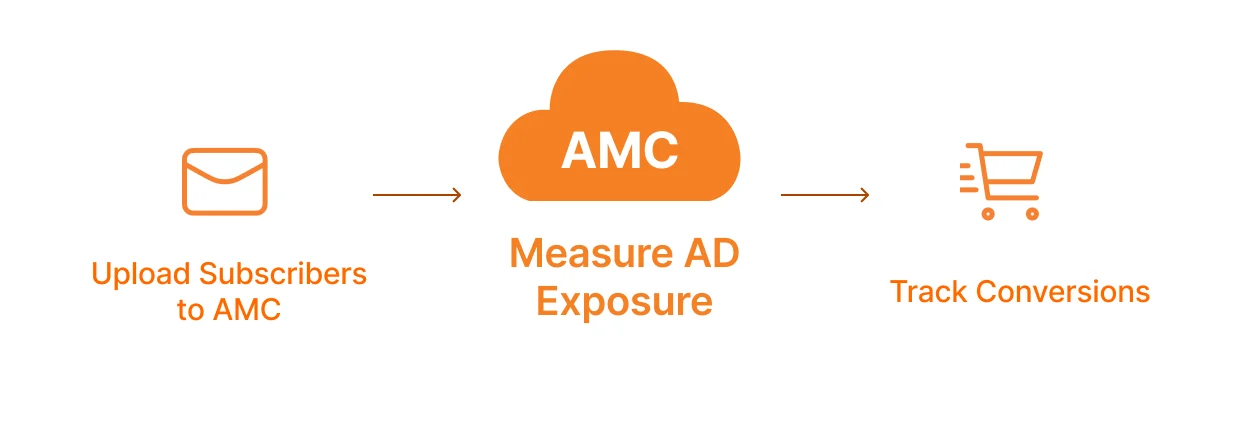
7. Sandbox Testing
Experimentation is essential to scaling with AMC, and the sandbox environment provides a safe place to test queries, refine audience logic, and train new team members without affecting live campaigns.
Example: An analyst practices building a cart-abandoner segment in the sandbox. By testing there first, they build accuracy and confidence before applying queries to active campaigns.
Why It Matters
Audience creation use cases in AMC empower sellers and brands to move away from broad, inefficient targeting and toward data-driven precision. These use cases allow you to re-engage high-intent shoppers, scale with high-value lookalikes, and combine signals across ad types for smarter segmentation.
Connecting the Dots: Targeting, Reporting & Attribution
Individually, AMC use cases deliver strong value. But the real power of Amazon Marketing Cloud comes when they work together in a closed loop where reporting generates insights, targeting activates them, and attribution validates the impact.
Think of this as building a full-funnel operating system for your Amazon advertising strategy.
Targeting: Smarter, More Precise Reach
AMC enables you to move beyond broad audience segments and design highly relevant, data-driven audiences. Whether you are building segments of cart abandoners, ad engagers, or high-value lookalikes, AMC ensures your campaigns reach shoppers with demonstrated intent. The outcome is more efficient spend and greater relevance at every stage of the funnel.
Reporting: Clarity Inside the Funnel
While standard console reports show you what happened, AMC helps you understand why it happened. With use cases such as shopping journey analysis, media mix modeling, and overlap analysis, you gain visibility into how campaigns interact, where shoppers disengage, and which ad types create the strongest momentum throughout the funnel.
Attribution: Proving ROI with Accuracy
The final piece of the loop is attribution. Instead of relying on last-click credit, AMC gives you the flexibility to apply custom attribution models that reflect real shopper behavior. Whether it is time-decay, position-based, or a hybrid model, AMC helps you allocate budgets fairly and with confidence, ensuring that each channel is evaluated by its true contribution.
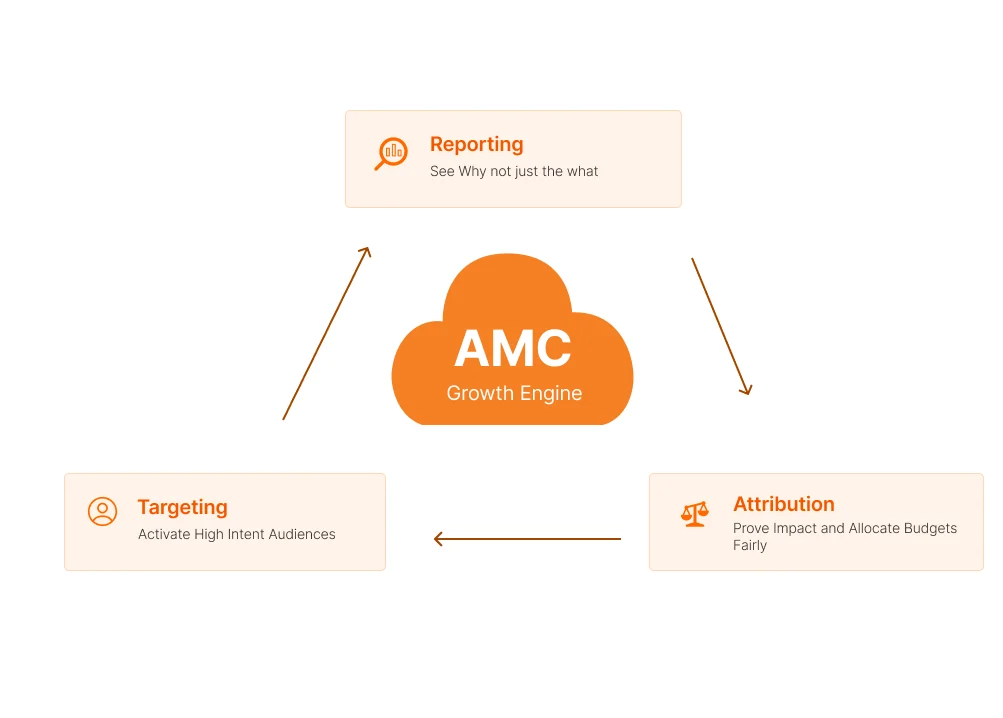
Example Workflow in Action
Here is what it looks like when these elements work together in practice:
- Reporting: A shopping journey analysis reveals that many shoppers add items to their cart after engaging with Sponsored Brands ads.
- Targeting: Build a cart-abandoner audience and reconnect with these high-intent shoppers using DSP.
- Attribution: Apply a custom attribution model to see how Sponsored Brands drove awareness, DSP re-engaged shoppers, and Sponsored Products closed the purchase.
Advanced & Emerging AMC Use Cases
Once the core reporting and targeting use cases are in place, Amazon Marketing Cloud evolves from being a measurement platform into a strategic growth engine. At this stage, brands can integrate AMC insights with broader marketing data, build more sophisticated models, and answer questions that go far beyond what the Ads Console can provide.
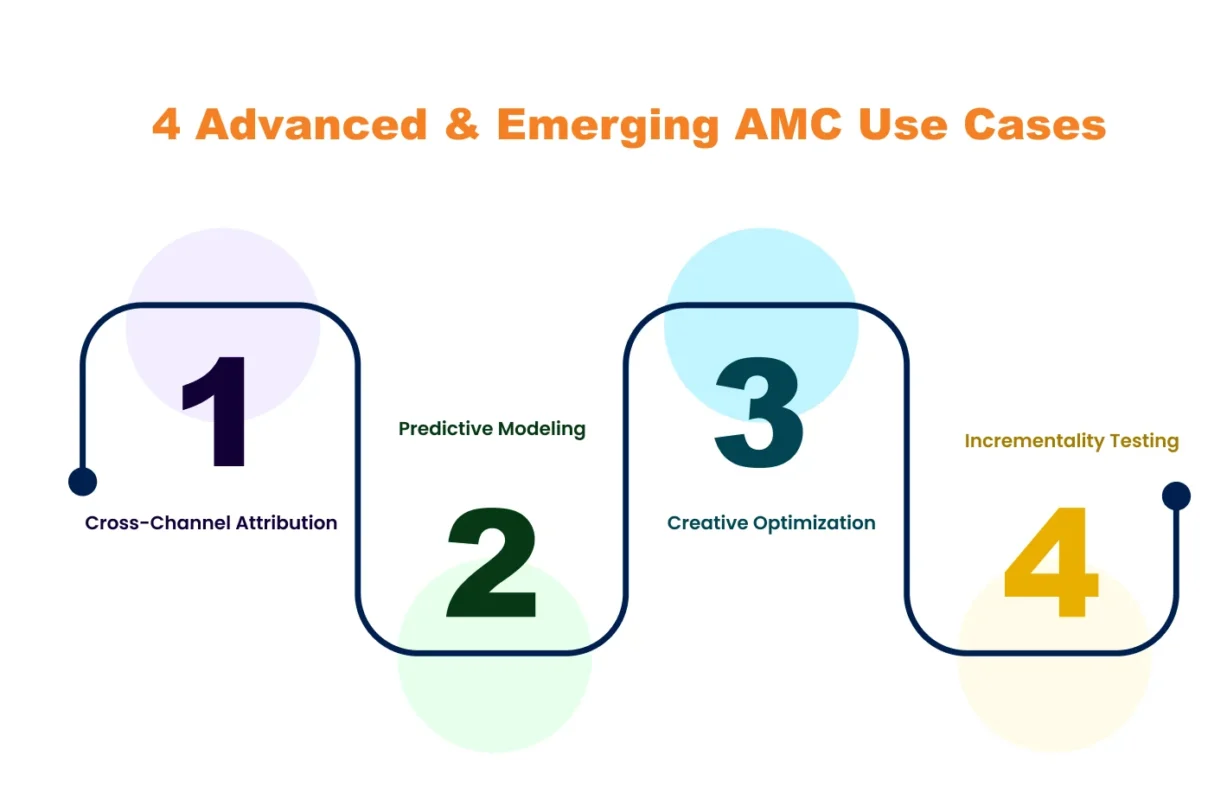
Here are some of the most impactful advanced and emerging use cases worth exploring:
1. Cross-Channel Attribution
Shoppers interact with multiple touchpoints before making a purchase, moving between Amazon, Google, Meta, retail stores, and DTC sites. AMC helps you understand Amazon’s role in this broader ecosystem by blending its event-level data with external platforms.
Example: By combining AMC data with GA4 or Meta Ads reporting, you might see that Amazon DSP impressions increase branded search queries on Google, or that Amazon ads improve remarketing performance on Meta. These insights allow you to optimize media investments across the entire customer journey, not just within Amazon.
2. Predictive Modeling
Because AMC stores event-level behavioral data, it can be used to build predictive models that support long-term growth strategies. This includes forecasting customer lifetime value (LTV), repeat purchase probability, or churn risk.
Example: A supplements brand could analyze reorder cycles for protein powder and predict when customers are most likely to purchase again. By using this insight, the brand can time retargeting campaigns more effectively, improving retention and strengthening customer relationships.
3. Creative Optimization
AMC is not limited to audience targeting. It can also inform which creative messages resonate best with specific segments by connecting audience behaviors with engagement outcomes.
Example: A fashion brand might learn that audiences acquired through Sponsored Brands Video respond better to lifestyle imagery, while DSP remarketing audiences convert more strongly with product-focused creative. AMC data helps tailor creative strategies at the audience level, ensuring relevance and higher impact.
4. Incrementality Testing
One of the most important questions in advertising is whether spend is driving incremental growth—or simply capturing conversions that would have happened anyway. AMC enables clean-room based incrementality testing, helping you measure the true effect of ad exposure.
Example: By comparing exposed and unexposed groups, a beverage brand can determine the incremental sales lift from a DSP campaign. This provides the clarity needed to scale budgets with confidence, backed by verified data.
Conclusion
Amazon Marketing Cloud is more than a reporting tool, it’s a strategy accelerator. When you use targeting use cases, you can shape audiences that are sharper and more relevant, reaching shoppers with real intent. Reporting use cases then give you visibility into the entire shopping journey, helping you see the media mix, campaign overlap, and the reasons behind performance, not just the surface results.
Attribution use cases take it further by moving past last-click models, giving every touchpoint fair credit so you can allocate budgets with clarity and prove true ROI. Together, these use cases form a cycle where insights guide actions, actions deliver outcomes, and those outcomes feed back into smarter strategy. The simplest way to start is by pairing one reporting use case with one targeting use case, then measuring results with a basic attribution model. This creates quick wins and builds the foundation for more advanced strategies over time.
FAQs
1. Do I need SQL to use AMC?
No. Amazon provides pre-built query templates, though basic SQL helps for advanced cases.
2. How is AMC different from the Ads Console?
The console shows what happened; AMC explains why it happened and what to do next.
3. What are the best starter use cases?
Shopping journey analysis, cart-abandoner audiences, and custom attribution models.
4. Is AMC only for big advertisers?
No. Smaller brands can still uncover useful insights, though larger spend unlocks more depth.
5. How does AMC improve campaigns?
It creates a closed loop: reporting → targeting → attribution → smarter ROI.



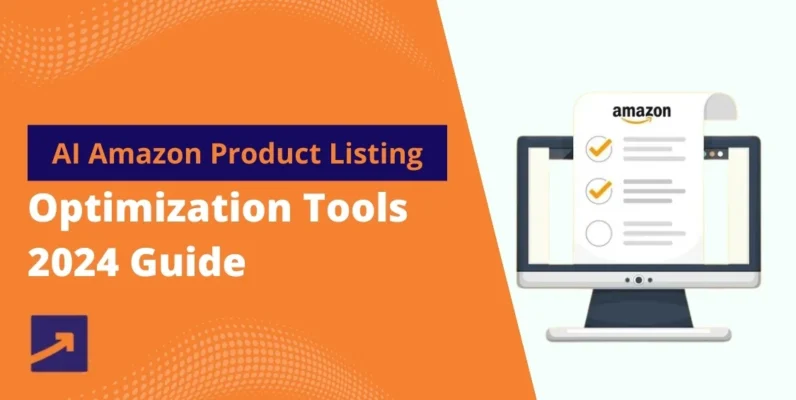
![How To Achieve Amazon Listing Optimization For Better Results [2024]](https://amzdudes.com/wp-content/uploads/2023/12/How-To-Achieve-Amazon-Listing-Optimization-For-Better-Results-20241-796x400.webp)